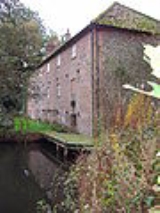
Hempstead Watermill
Encyclopedia
Hempstead Watermill is a disused watermill 1.7 miles south east of the town of Holt
in the English
county of Norfolk
.. The mill stands on the River Glaven
and the lane between Holt and the village of Hempstead
. The mill was built in 1830 by Richard John Gurney and was originally called Holt Watermill.
was added to the set of buildings. The bread
oven had been supplyied by T. Collins & Co of Bristol
. The oven was fired using coke, as was the twenty gallon
capacity boiler that supplied hot water and regulated the oven.
The oven had a capacity to produce 208 1 lb loves and was fired up twice before deliveries went out to the surrounding population. Water for the bread making was carried by bucket from a spring on the opposite side of the road.
Holt, Norfolk
Holt is a market town and civil parish in the English county of Norfolk. The town is north of the city of Norwich, west of Cromer and east of King's Lynn. The town is on the route of the A148 King's Lynn to Cromer road. The nearest railway station is in the town of Sheringham where access to the...
in the English
England
England is a country that is part of the United Kingdom. It shares land borders with Scotland to the north and Wales to the west; the Irish Sea is to the north west, the Celtic Sea to the south west, with the North Sea to the east and the English Channel to the south separating it from continental...
county of Norfolk
Norfolk
Norfolk is a low-lying county in the East of England. It has borders with Lincolnshire to the west, Cambridgeshire to the west and southwest and Suffolk to the south. Its northern and eastern boundaries are the North Sea coast and to the north-west the county is bordered by The Wash. The county...
.. The mill stands on the River Glaven
River Glaven
The River Glaven is 10½ miles long and flows through picturesque North Norfolk countryside. Rising from a tiny headwater in Bodham the river starts just 2 miles before Selbrigg Pond where three streams combine at the outfall...
and the lane between Holt and the village of Hempstead
Hempstead, near Holt, Norfolk
Hempstead is a village and civil parish in the north of the English county of Norfolk. The village is 2.7 miles south-southeast of the town of Holt, and 11.2 miles west of Cromer. Hempstead is within the area covered by North Norfolk District Council...
. The mill was built in 1830 by Richard John Gurney and was originally called Holt Watermill.
Description
The watermill and its adjoining mill house are constructed from local brick and flint and the buildings have red Norfolk pantiled roofs. The river Glaven was dammed and a large mill pond stands directly behind the mill.History
Hempstead Watermill was powered by the use of a water wheel until 1905 when the wheel was removed and replaced with a more efficient turbine. The turbine was controlled by a sluice which was also installed at the time. At the time of these changes the mill had five sources of water. They were the upper pond which was swept away in floods in 1912, Old Decoy now called Selbrigg Pond, New Decoy and Horsepit Pond. This last pond was originally the farm horse pond for near-by Red House Farm, the pond was supplemented with water that was runoff from the farm and its buildings. A sluice had been added to the pond in order to increase the water in the mill pond. Even then the mill only had enough water to run for a limit of five hours. In later years a traction engine ran the mill via a pulley wheel on the outside of the building.The watermill operated two pairs of stones, although most of the time, only one pair would be working due to lack of water. A circular timber saw blade set in a steel bench was also powered from the Turbine and was still in operation up until 1977. It was used to cut timber for the Gurney Estate. The shed that sheltered the bench has long disappeared. The watermill also included a number of cartsheds, haylofts, stables, pig sties and cowsheds.Bakery
In 1911 a bakeryBakery
A bakery is an establishment which produces and sells flour-based food baked in an oven such as bread, cakes, pastries and pies. Some retail bakeries are also cafés, serving coffee and tea to customers who wish to consume the baked goods on the premises.-See also:*Baker*Cake...
was added to the set of buildings. The bread
Bread
Bread is a staple food prepared by cooking a dough of flour and water and often additional ingredients. Doughs are usually baked, but in some cuisines breads are steamed , fried , or baked on an unoiled frying pan . It may be leavened or unleavened...
oven had been supplyied by T. Collins & Co of Bristol
Bristol
Bristol is a city, unitary authority area and ceremonial county in South West England, with an estimated population of 433,100 for the unitary authority in 2009, and a surrounding Larger Urban Zone with an estimated 1,070,000 residents in 2007...
. The oven was fired using coke, as was the twenty gallon
Gallon
The gallon is a measure of volume. Historically it has had many different definitions, but there are three definitions in current use: the imperial gallon which is used in the United Kingdom and semi-officially within Canada, the United States liquid gallon and the lesser used United States dry...
capacity boiler that supplied hot water and regulated the oven.
The oven had a capacity to produce 208 1 lb loves and was fired up twice before deliveries went out to the surrounding population. Water for the bread making was carried by bucket from a spring on the opposite side of the road.

